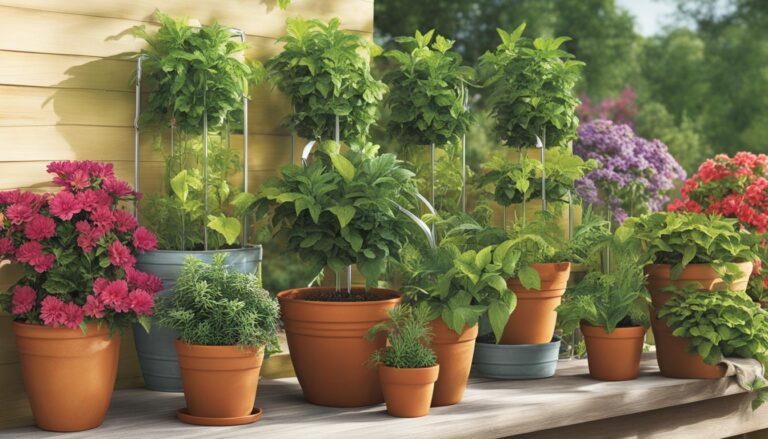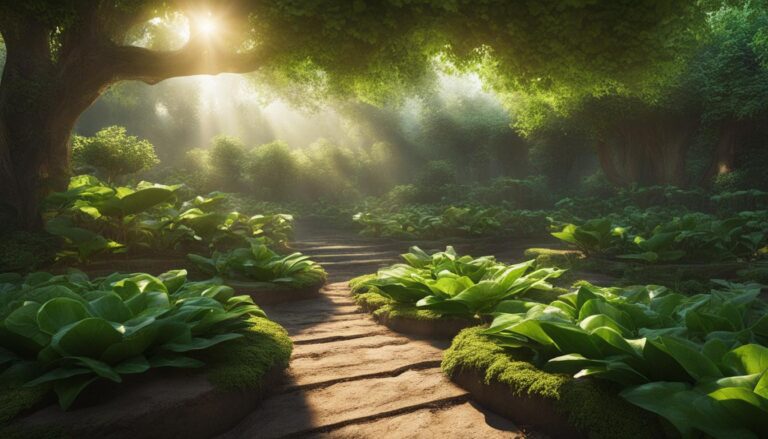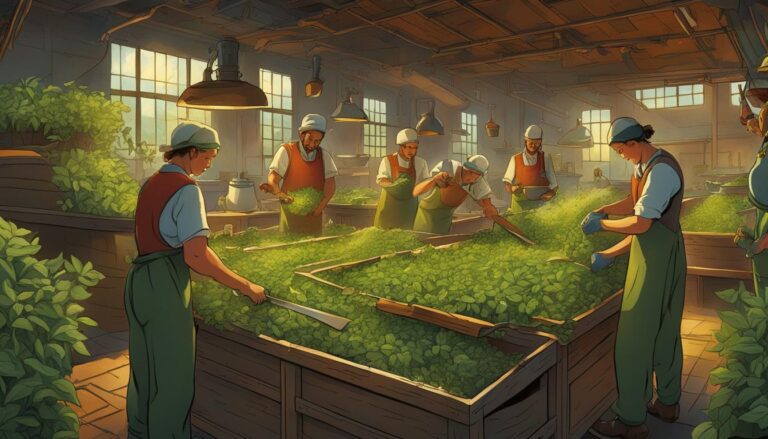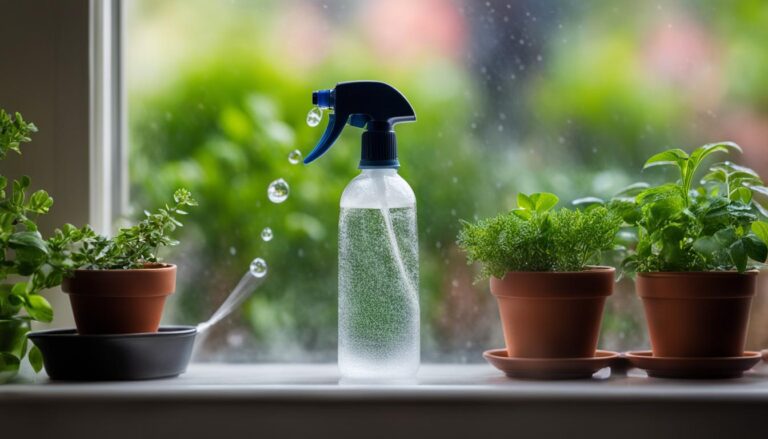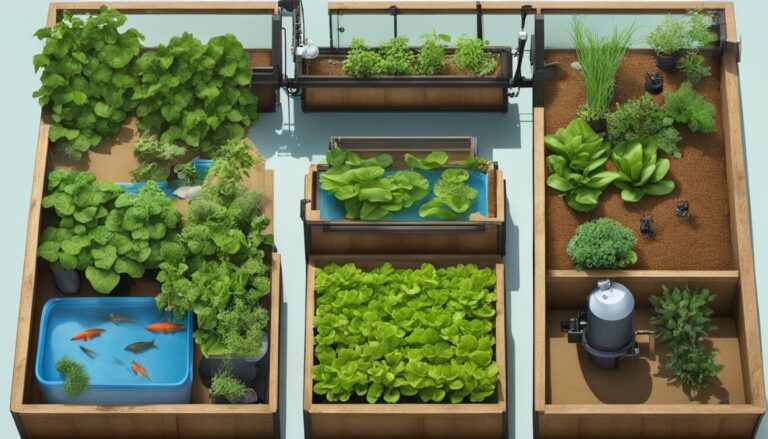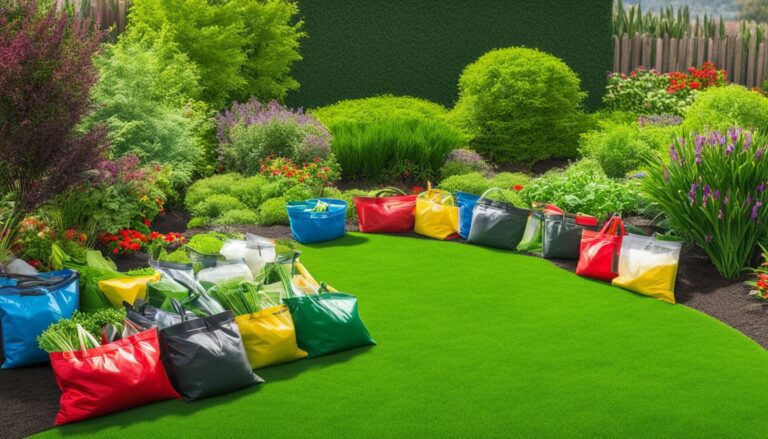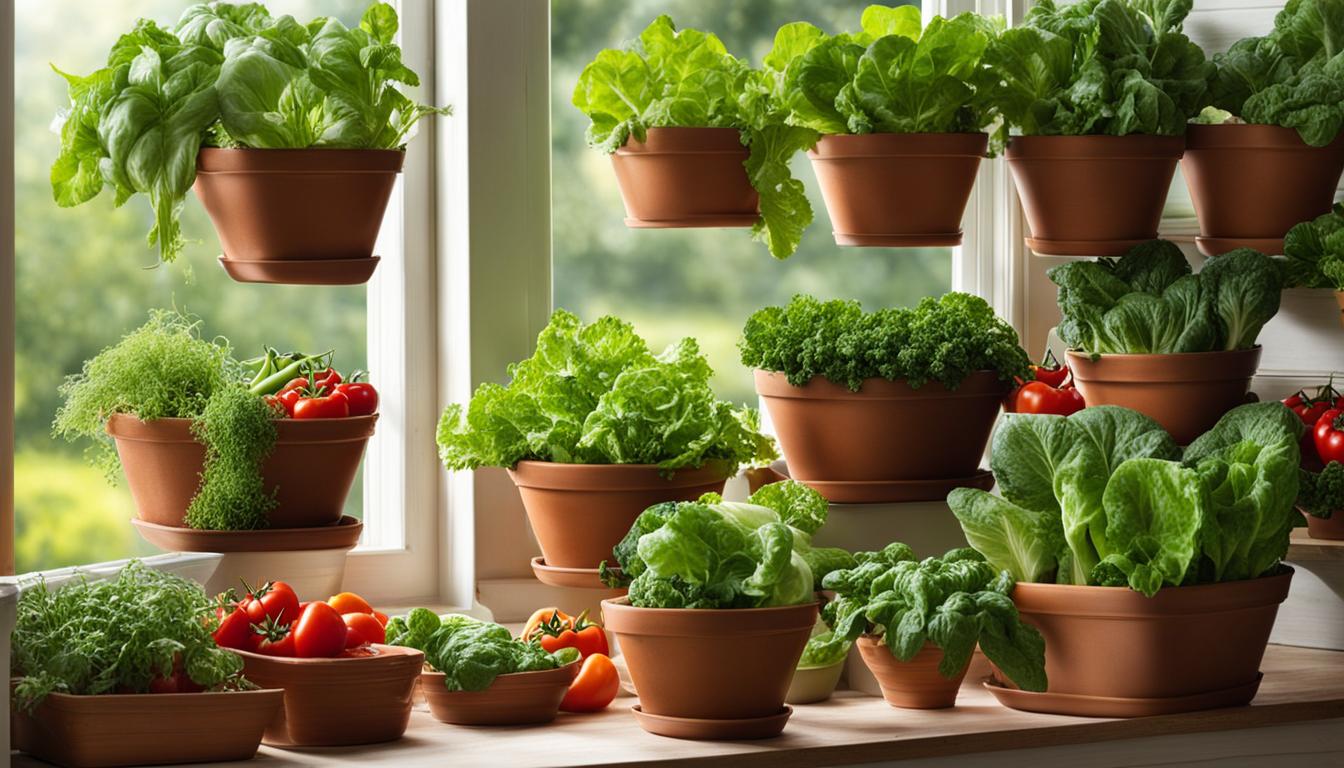
Growing vegetables indoors can be a convenient and efficient way to produce fresh food, especially if you have limited space.
The choice of container plays a crucial role in the success of your indoor vegetable garden. It is important to select containers that provide enough room for the root system to develop and ensure stability for larger plants.
Larger pots, with a minimum diameter of 18 inches and a depth of 18 inches or a volume of five gallons, are recommended for plants like cucumbers, eggplants, squash, or broccoli. Compact and miniature varieties are often better suited for container gardening.
Key Takeaways:
- Choose containers that allow enough room for root development and stability.
- Larger pots are recommended for bigger plants, while compact varieties are better for container gardening.
- Consider the size, shape, material, and color of the container when selecting.
- Materials like wood, plastic, terra cotta, and glazed ceramic all have pros and cons.
- Select container sizes based on the specific vegetables being grown.
Factors to Consider when Choosing Containers for Indoor Vegetable Gardening
When it comes to indoor vegetable gardening, choosing the right containers is essential for the success of your plants. There are several factors to consider when selecting containers, including size, shape, material, and color.
Size: The size of the container should be appropriate for the vegetable you plan to grow. Larger plants require more soil volume, so make sure to choose a container that provides enough space for the roots to grow and develop properly.
Shape: The shape of the container can affect water distribution and root development. Straight-sided containers are generally preferred as they allow for even moisture distribution and encourage healthy root growth.
Material: The material of the container can impact heat retention and moisture levels. Different materials, such as wood, clay, plastic, or fabric, have different properties. Consider the specific needs of your plants and choose a material that will provide the best growing conditions.
Color: The color of the container can also play a role in indoor vegetable gardening. Dark-colored containers absorb more heat, which can be beneficial for certain plants, while light-colored containers reflect heat and help keep the roots cool.
Factors to Consider when Choosing Containers for Indoor Vegetable Gardening
| Factors | Description |
|---|---|
| Size | Choose a container that provides enough space for the roots to grow and develop properly. |
| Shape | Straight-sided containers allow for even moisture distribution and healthy root growth. |
| Material | Select a material that will provide the best growing conditions for your plants. |
| Color | Consider the color of the container, as it can impact heat absorption and root temperature. |
By considering these factors and choosing the right containers for your indoor vegetable garden, you can create an optimal growing environment and set yourself up for a successful harvest.
Recommended Container Materials for Indoor Vegetable Gardening
Choosing the right container material is important for the success of your indoor vegetable garden. Each material has its own advantages and disadvantages, so it’s essential to consider your specific needs and preferences. Here are some of the recommended container materials for indoor vegetable gardening:
Wood
Wooden containers are a popular choice for indoor gardening due to their attractiveness and durability. They provide insulation and retain soil moisture, creating a favorable environment for vegetable growth. However, it’s important to note that wood containers may require more frequent watering compared to other materials.
Plastic
Plastic pots are lightweight, affordable, and widely available. They come in various sizes and shapes, making them suitable for different types of vegetables. However, plastic containers can retain too much heat and may require additional measures to control soil moisture levels.
Terra Cotta
Terra cotta pots have a classic look and are known for their ability to retain moisture. They provide good drainage and help regulate soil moisture levels. However, they can be heavy and may require frequent watering to prevent drying out.
Glazed Ceramic
Glazed ceramic pots are visually appealing and come in a wide range of colors and designs. They do not absorb moisture and provide good insulation for the roots. However, they can be more expensive compared to other materials.
Smart Pots
Smart pots, made of fabric, offer several advantages for indoor vegetable gardening. They provide better aeration for the roots and retain moisture while preventing overwatering. They are also lightweight and easy to move around. Smart pots come in various sizes and are ideal for growing a variety of vegetables.
Container Sizes for Different Vegetables in Indoor Gardening
Choosing the right container size is crucial for the successful growth of vegetables in indoor gardens. Different vegetables have varying root depths and growth habits, which determine the size of the container they require. Here are some recommendations for container sizes for different vegetables:
Lettuce and Spinach:
Shallow-rooted vegetables like lettuce and spinach can thrive in containers with a depth of 4-8 inches. These leafy greens do not require extensive root space and can be grown in smaller pots.
Tomatoes and Peppers:
Fruits such as tomatoes and peppers require larger containers due to their deeper root systems. A minimum container size of 5 gallons is recommended to provide adequate space for root development and ensure stability for these taller plants.
Cucumbers, Squash, and Melons:
Larger vegetables like cucumbers, squash, and melons need containers with a greater volume. It is recommended to use containers ranging from 10-24 inches in depth to accommodate their extensive root systems and allow room for growth.
By selecting the appropriate container size for each vegetable, you can provide the necessary space for root development and promote healthy growth in your indoor vegetable garden.

| Vegetable | Container Size |
|---|---|
| Lettuce | 4-8 inches depth |
| Spinach | 4-8 inches depth |
| Tomatoes | Minimum 5 gallons |
| Peppers | Minimum 5 gallons |
| Cucumbers | 10-24 inches depth |
| Squash | 10-24 inches depth |
| Melons | 10-24 inches depth |
Refer to the table above for a quick reference on recommended container sizes for different vegetables in indoor gardening.
Recommended Vegetable Varieties for Container Gardening
When it comes to container gardening, choosing the right vegetable varieties is essential for success. Certain vegetables are better suited for growing in containers due to their compact growth habit.
These varieties are specifically bred for container gardening and are perfect for indoor vegetable gardens. Here are some recommended vegetable varieties for container gardening:
Compact Eggplant Varieties
Eggplants are a popular choice for container gardening due to their manageable size. Compact eggplant varieties like ‘Meatball’ and ‘Patio Baby’ are ideal for growing in containers. They produce small to medium-sized fruit and have a bushy growth habit, making them perfect for limited indoor spaces.
Bush Tomatoes
If you’re a fan of fresh tomatoes, try growing bush tomato varieties in containers. ‘Husky Cherry’ is a popular choice as it produces cherry tomatoes on compact, bushy plants. These tomatoes thrive in containers and provide a bountiful harvest of sweet and juicy fruits.
Compact Cucumber Varieties
Cucumbers are another great vegetable for container gardening. Compact cucumber varieties like ‘Bush Slicer’ are perfect for small spaces and produce an abundance of crisp and delicious cucumbers. These varieties have a compact growth habit and can be grown in containers with ease.
By choosing these recommended vegetable varieties for container gardening, you can enjoy a bountiful harvest of fresh vegetables in your indoor garden. These compact varieties are well-suited to the space limitations of container gardening and will thrive in your indoor vegetable garden.
Table: Recommended Vegetable Varieties for Container Gardening
| Vegetable | Variety | Description |
|---|---|---|
| Eggplant | ‘Meatball’ | A compact variety that produces small to medium-sized fruit. Perfect for container gardening. |
| Eggplant | ‘Patio Baby’ | A bushy variety that is well-suited for small spaces. Produces an abundance of flavorful eggplants. |
| Tomato | ‘Husky Cherry’ | A compact bush variety that produces cherry tomatoes. Ideal for container gardening. |
| Cucumber | ‘Bush Slicer’ | A compact cucumber variety that produces crisp and delicious cucumbers. Perfect for small containers. |
Tips for Successful Indoor Vegetable Gardening
Indoor vegetable gardening can be a rewarding and efficient way to grow fresh produce in the comfort of your own home. To ensure the success of your indoor garden, here are some important tips to keep in mind:
Provide Adequate Lighting
Most vegetables require at least 6-8 hours of light per day to thrive. If your indoor space does not receive enough natural sunlight, consider supplementing with artificial lighting. LED grow lights are a popular choice as they provide the right spectrum of light for plant growth.
Choose the Right Soil
A well-draining potting mix is essential for indoor vegetable gardening. Look for a mix that is specifically formulated for container gardening and is rich in organic matter. Avoid using garden soil as it may contain pests or pathogens that can harm your plants.
Monitor Soil Moisture Levels
Regularly check the moisture levels of your soil and water your plants accordingly. Overwatering can lead to root rot, while underwatering can cause your plants to wilt. In general, it’s better to slightly underwater than overwater, as most vegetables can recover from short periods of drought.
Proper ventilation is also important for indoor vegetable gardening. Good air circulation helps prevent the growth of mold and fungal diseases. If necessary, use fans or open windows to improve airflow in your indoor space.
Lastly, be sure to monitor your plants for pests and diseases. Regularly inspect the leaves and stems for any signs of infestation and take appropriate measures to control them, such as using organic insecticidal soaps or natural predators.
Table: Recommended Indoor Vegetable Gardening Tips
| Tips | Description |
|---|---|
| Provide Adequate Lighting | Ensure your plants receive at least 6-8 hours of light per day, or supplement with artificial lighting. |
| Choose the Right Soil | Use a well-draining potting mix specifically formulated for container gardening. |
| Monitor Soil Moisture Levels | Regularly check the moisture levels of your soil and water your plants accordingly. |
| Ensure Proper Ventilation | Good airflow helps prevent the growth of mold and fungal diseases. |
| Monitor for Pests and Diseases | Regularly inspect your plants for signs of infestation and take appropriate measures to control pests. |
By following these tips, you can create a successful indoor vegetable garden and enjoy the benefits of fresh homegrown produce all year round.
Best Practices for Container Gardening in Indoor Spaces
When engaging in container gardening for vegetables indoors, there are several best practices you should follow to optimize the growth and productivity of your plants. By implementing these strategies, you can create an ideal environment for your indoor garden.
1. Use High-Quality Potting Soil
Selecting the right potting soil is essential for the success of your indoor vegetable garden. Choose a high-quality, well-draining potting mix that is rich in nutrients. This will provide the necessary support and nourishment for your plants to thrive.
2. Provide Good Drainage
Proper drainage is crucial to prevent waterlogging and root rot. Ensure that your containers have adequate drainage holes to allow excess water to escape. You can also use a layer of gravel or small stones at the bottom of the container to improve drainage.
3. Avoid Overcrowding
Give each plant enough space to grow and flourish by avoiding overcrowding in your containers. Overcrowded plants can compete for resources and become more susceptible to diseases and pests. Follow the recommended spacing guidelines for each vegetable variety to promote optimal growth.
4. Regularly Fertilize Your Plants
Indoor plants rely on you for their nutrient needs. Regularly fertilize your plants with organic nutrients or a balanced fertilizer to provide them with essential minerals and promote healthy growth. Follow the manufacturer’s instructions for application rates and frequency.
5. Monitor Temperature and Humidity
Temperature and humidity levels play a significant role in the success of your indoor vegetable garden. Ensure that your plants are kept in an environment with optimal temperature and humidity levels for their specific needs. Use a thermometer and hygrometer to monitor these conditions regularly.
6. Regularly Rotate Your Containers
To promote even growth and prevent issues caused by lack of sunlight or airflow, regularly rotate your containers. This will ensure that all sides of your plants receive adequate light and air circulation, preventing the development of leggy growth or uneven foliage.
By following these best practices for container gardening in indoor spaces, you can create a thriving and productive indoor vegetable garden.
Whether you have limited outdoor space or simply enjoy the convenience of growing your own food indoors, container gardening is a rewarding and sustainable option for all plant enthusiasts.
Benefits of Indoor Vegetable Gardening in Containers
Indoor vegetable gardening in containers offers numerous benefits that make it an attractive option for gardeners, especially those with limited outdoor space.
By utilizing containers, individuals can still enjoy the rewards of homegrown vegetables without the need for a traditional outdoor garden. One of the primary advantages is the greater control over growing conditions, including temperature, humidity, and sunlight.
This control allows for the creation of an optimal environment for vegetable growth, promoting healthier and more productive plants.
Another benefit of indoor vegetable gardening in containers is the reduced risk of pests and diseases commonly found in traditional outdoor gardens.
By keeping plants indoors, gardeners can minimize the presence of harmful insects and pathogens, leading to healthier and more vibrant vegetables.
This reduced risk of pests and diseases also eliminates the need for chemical pesticides, making indoor vegetable gardening a more sustainable and eco-friendly option.
Additionally, indoor vegetable gardening in containers can be aesthetically pleasing and serve as a decorative element in the home. Containers come in a variety of materials, shapes, and colors, allowing gardeners to choose options that complement their interior design. The presence of vibrant, green plants can add a refreshing and inviting touch to any space.
Furthermore, indoor vegetable gardening offers the opportunity to incorporate fresh, homegrown produce into one’s diet. By growing vegetables indoors, individuals can enjoy the convenience of having healthy and nutritious food readily available.
This can lead to a greater appreciation for sustainable living and a sense of accomplishment in providing for oneself.
Benefits of Indoor Vegetable Gardening in Containers
| Advantages | Description |
|---|---|
| Greater control over growing conditions | Allows for optimal temperature, humidity, and sunlight levels |
| Reduced risk of pests and diseases | Eliminates the need for chemical pesticides |
| Aesthetic appeal | Complements interior design and adds a refreshing touch |
| Access to fresh produce | Provides a convenient source of healthy and nutritious food |
Common Mistakes to Avoid in Indoor Vegetable Gardening
Indoor vegetable gardening is a rewarding and convenient way to grow your own fresh produce. However, there are common mistakes that can hinder the success of your indoor garden. By being aware of these mistakes and taking proactive measures, you can ensure the health and productivity of your plants.
Overwatering
One of the most common mistakes in indoor vegetable gardening is overwatering. It’s easy to think that more water equates to healthier plants, but excessive moisture can lead to root rot and other fungal diseases. It’s important to water your plants only when the top inch of soil feels dry. Avoid letting water accumulate in trays or saucers, as this can lead to waterlogged roots.
Poor Drainage and Improper Soil Selection
Proper drainage is essential for the health of your plants. If your containers don’t have drainage holes, excess water can accumulate and cause root rot. Make sure to choose containers with drainage holes or create your own if necessary. Additionally, using a well-draining potting mix specifically formulated for indoor gardening can help prevent waterlogged soil.
Inadequate Lighting
Light is crucial for the growth and development of plants. If your indoor vegetable garden is not receiving enough natural light, consider supplementing with artificial lighting. Most vegetables require at least 6-8 hours of light per day. Position your plants near a south-facing window or use grow lights to provide the necessary light intensity and duration.
Starting with Too Many or Unsuitable Varieties
It can be tempting to start your indoor garden with a wide variety of vegetables, but overcrowding can lead to competition for resources and hinder growth. Additionally, not all vegetables are well-suited for indoor gardening. Research and choose varieties that are specifically bred for container gardening and are suitable for the size and conditions of your indoor space.
| Mistake | Impact |
|---|---|
| Overwatering | Root rot and fungal diseases |
| Poor Drainage and Improper Soil Selection | Waterlogged roots and poor plant health |
| Inadequate Lighting | Stunted growth and weak plants |
| Starting with Too Many or Unsuitable Varieties | Overcrowding and competition for resources |
By avoiding these common mistakes, you can maximize the success of your indoor vegetable garden. Remember to monitor your plants regularly, provide the right amount of water and light, and choose appropriate varieties for your space. With proper care and attention, you can enjoy a thriving and bountiful indoor garden.
Additional Tips for Successful Indoor Vegetable Gardening
When it comes to successful indoor vegetable gardening, there are a few additional tips that can help you maximize your results. Consider implementing the following techniques to enhance your gardening experience:
1. Use self-watering containers or drip irrigation systems
Consistent moisture is essential for the healthy growth of indoor vegetables. To ensure your plants receive adequate water without the risk of overwatering, consider using self-watering containers or setting up a drip irrigation system. These methods provide a controlled and consistent water supply, preventing under or over-watering.
2. Regularly prune and pinch back your plants
To encourage bushier growth and prevent legginess in your indoor vegetable plants, make sure to regularly prune and pinch back the foliage. This helps redirect energy to new growth and improves overall plant health. Additionally, removing dead or diseased leaves can reduce the risk of pests and diseases.
3. Provide support for vining and climbing vegetables
If you are growing vining or climbing vegetables such as tomatoes or cucumbers, it is important to provide appropriate support for their growth. Stakes, trellises, or cages can help keep the plants upright and prevent them from sprawling across your indoor space. This also improves airflow and makes harvesting easier.
4. Harvest your vegetables when ripe
Regularly check and harvest your indoor vegetables when they reach peak ripeness. Harvesting encourages continued production and prevents overripe or spoiled vegetables. By harvesting at the right time, you can enjoy the freshest flavors and optimize the yield of your indoor garden.
By implementing these additional tips, you can further enhance the success of your indoor vegetable gardening endeavors. Remember to adapt these techniques based on the specific requirements of your plants and provide them with the necessary care and attention they need to thrive.
About the author
John Smith is an avid indoor gardener with years of experience in growing vegetables in limited spaces. He enjoys sharing his knowledge and passion for gardening through writing and workshops. John believes that anyone can create a thriving indoor vegetable garden with the right techniques and a little bit of patience.
Selecting the best containers for growing vegetables indoors is essential for the success of your indoor vegetable garden. By considering factors such as container size, shape, material, and color, you can create an optimal environment for your plants to thrive.
Also, choosing varieties of vegetables that are well-suited for container gardening will ensure better results.
By following best practices, such as providing adequate sunlight or artificial lighting, using a well-draining potting mix, and monitoring soil moisture levels, you can create the ideal growing conditions for your indoor vegetable garden. Implementing proper ventilation and pest control measures will also contribute to the health and productivity of your plants.
Indoor vegetable gardening in containers offers several benefits, including the ability to grow fresh produce in limited spaces, greater control over growing conditions, and reduced risk of pests and diseases. With careful planning, research, and attention to detail, you can enjoy the convenience and satisfaction of growing your own vegetables indoors.
FAQ
What factors should I consider when choosing containers for indoor vegetable gardening?
Factors to consider when choosing containers for indoor vegetable gardening include size, shape, material, and color.
What are the recommended container sizes for different vegetables in indoor gardening?
Shallow-rooted vegetables like lettuce and spinach can thrive in containers with a depth of 4-8 inches, while larger vegetables like cucumbers and squash require containers with a greater depth ranging from 10-24 inches.
Are there specific vegetable varieties that are better suited for container gardening?
Yes, compact, miniature, or bush varieties of vegetables are well-suited for container gardening due to their compact growth habit.
What are some tips for successful indoor vegetable gardening?
Tips for successful indoor vegetable gardening include providing adequate light, using a well-draining potting mix, monitoring soil moisture levels, ensuring proper ventilation, and regularly checking for pests and diseases.
What are some common mistakes to avoid in indoor vegetable gardening?
Common mistakes to avoid in indoor vegetable gardening include overwatering, poor drainage, improper soil selection, inadequate lighting, overcrowding containers, and starting with too many or the wrong varieties of vegetables.
Are there any additional tips for successful indoor vegetable gardening?
Additional tips for successful indoor vegetable gardening include using self-watering containers or a drip irrigation system, pruning and pinching back plants, implementing plant support structures, and regularly harvesting ripe vegetables.

